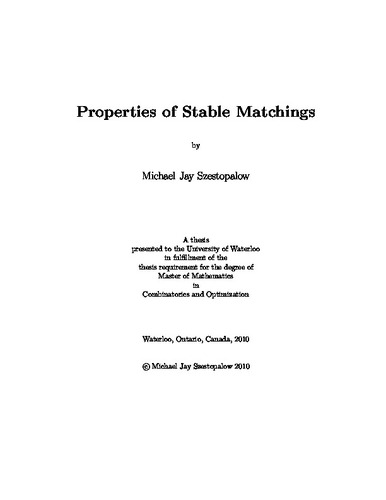| dc.description.abstract | Stable matchings were introduced in 1962 by David Gale and Lloyd Shapley to study the college admissions problem. The seminal work of Gale and Shapley has motivated hundreds of research papers and found applications in many areas of mathematics, computer science, economics, and even medicine. This thesis studies stable matchings in graphs and hypergraphs.
We begin by introducing the work of Gale and Shapley. Their main contribution was the proof that every bipartite graph has a stable matching. Our discussion revolves around the Gale-Shapley algorithm and highlights some of the interesting properties of stable matchings in bipartite graphs. We then progress to non-bipartite graphs. Contrary to bipartite graphs, we may not be able to find a stable matching in a non-bipartite graph. Some of the work of Irving will be surveyed, including his extension of the Gale-Shapley algorithm. Irving's algorithm shows that many of the properties of bipartite stable matchings remain when the general case is examined.
In 1991, Tan showed how to extend the fundamental theorem of Gale and Shapley to non-bipartite graphs. He proved that every graph contains a set of edges that is very similar to a stable matching. In the process, he found a characterization of graphs with stable matchings based on a modification of Irving's algorithm. Aharoni and Fleiner gave a non-constructive proof of Tan's Theorem in 2003. Their proof relies on a powerful topological result, due to Scarf in 1965. In fact, their result extends beyond graphs and shows that every hypergraph has a fractional stable matching. We show how their work provides new and simpler proofs to several of Tan's results.
We then consider fractional stable matchings from a linear programming perspective. Vande Vate obtained the first formulation for complete bipartite graphs in 1989. Further, he showed that the extreme points of the solution set exactly correspond to stable matchings. Roth, Rothblum, and Vande Vate extended Vande Vate's work to arbitrary bipartite graphs. Abeledo and Rothblum further noticed that this new formulation can model fractional stable matchings in non-bipartite graphs in 1994. Remarkably, these formulations yield analogous results to those obtained from Gale-Shapley's and Irving's algorithms. Without the presence of an algorithm, the properties are obtained through clever applications of duality and complementary slackness.
We will also discuss stable matchings in hypergraphs. However, the desirable properties that are present in graphs no longer hold. To rectify this problem, we introduce a new ``majority" stable matchings for 3-uniform hypergraphs and show that, under this stronger definition, many properties extend beyond graphs. Once again, the linear programming tools of duality and complementary slackness are invaluable to our analysis. We will conclude with a discussion of two open problems relating to stable matchings in 3-uniform hypergraphs. | en |

